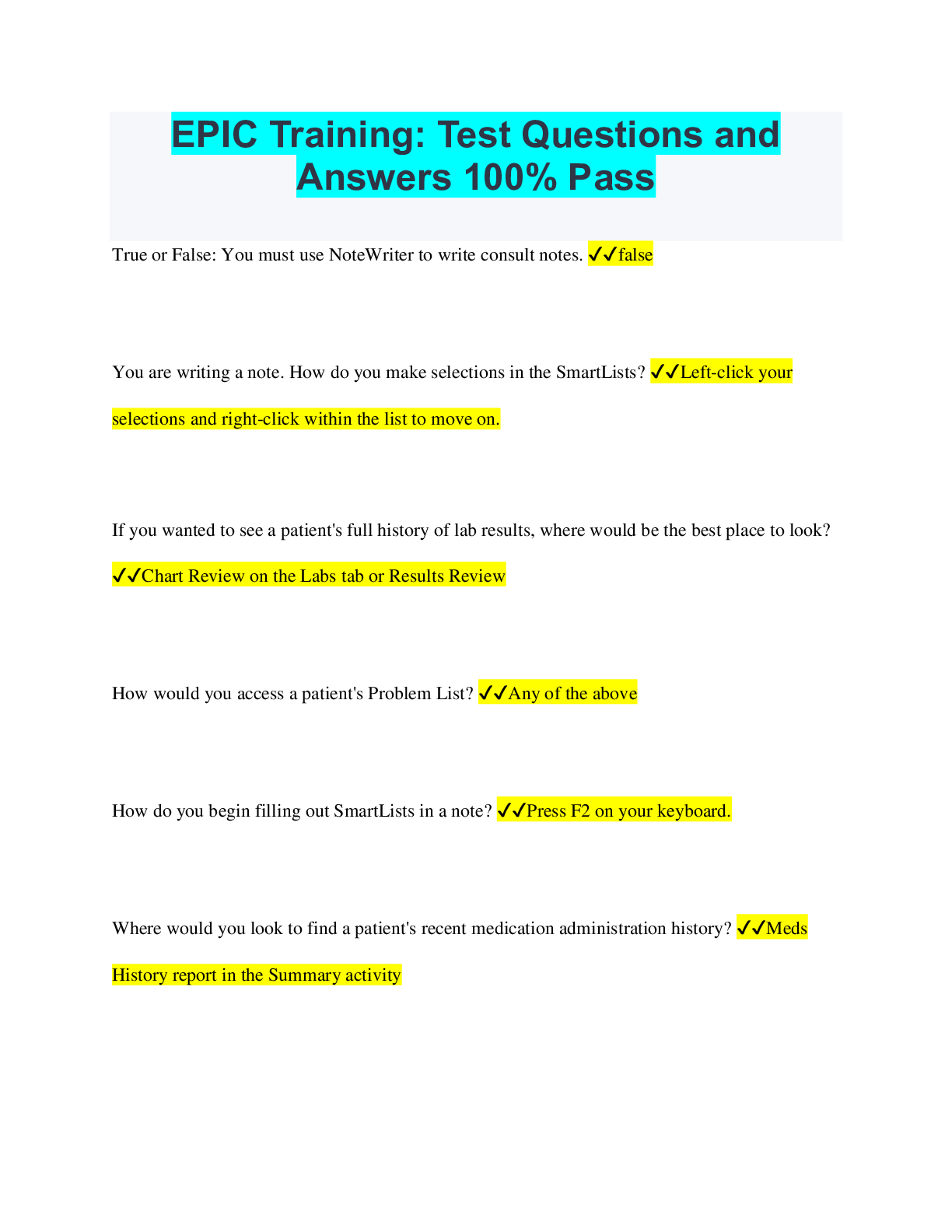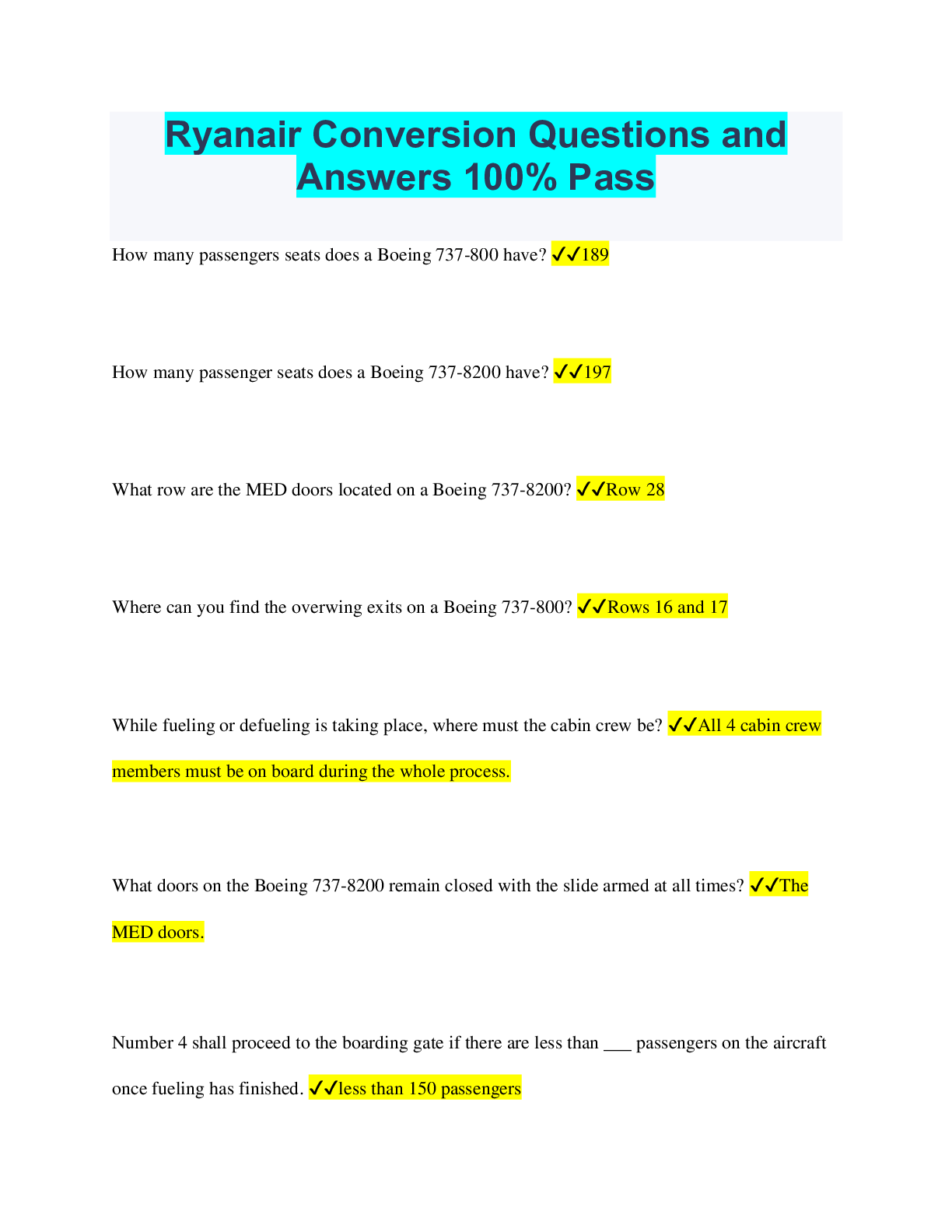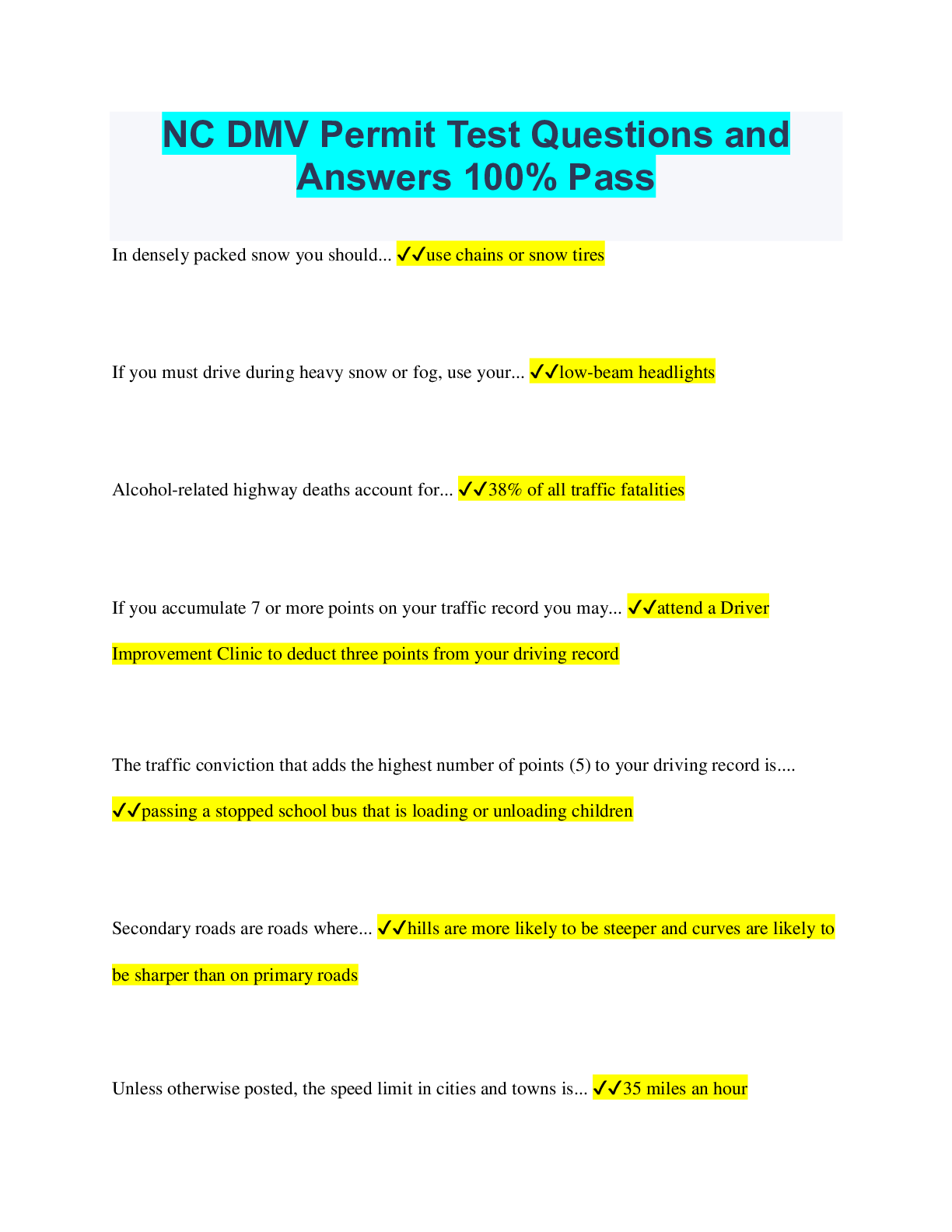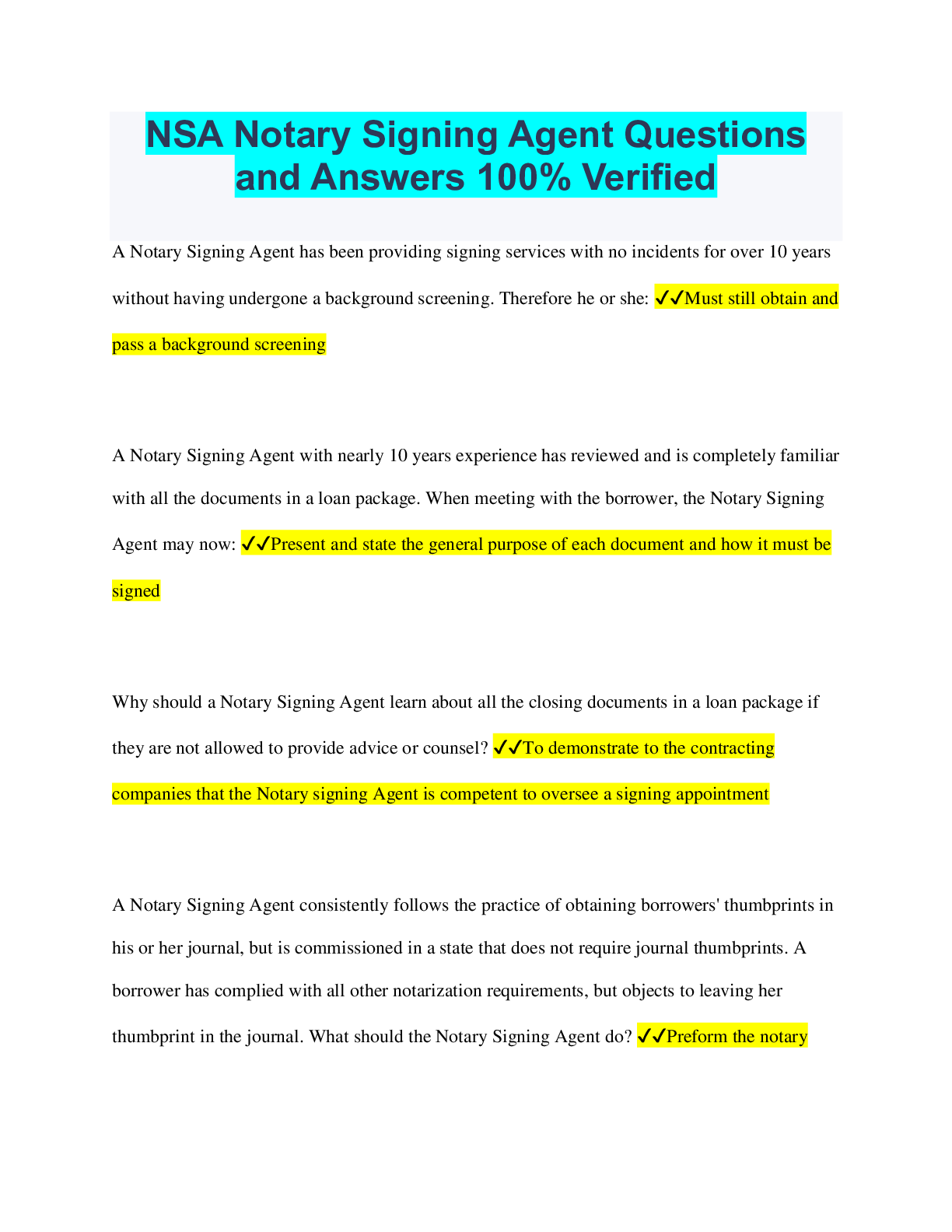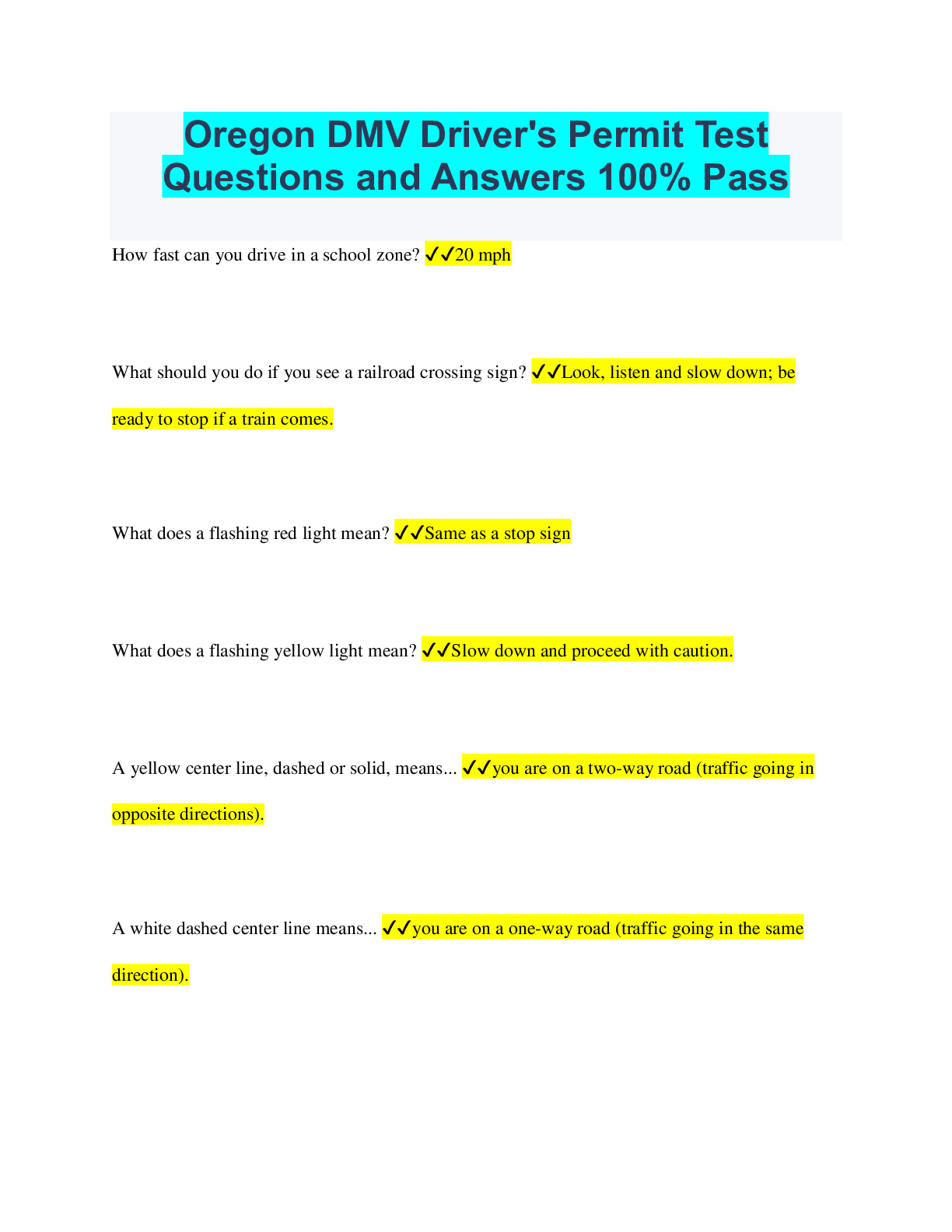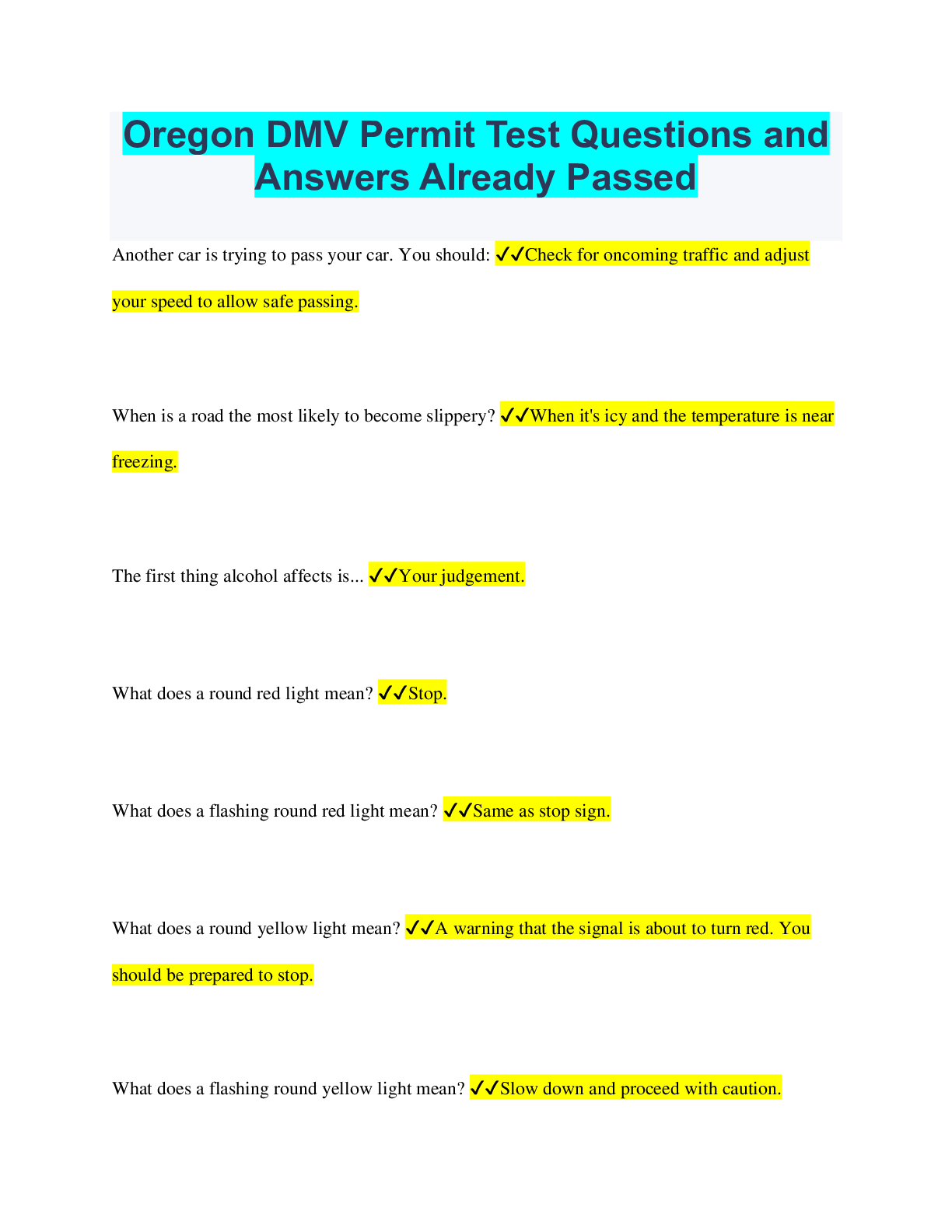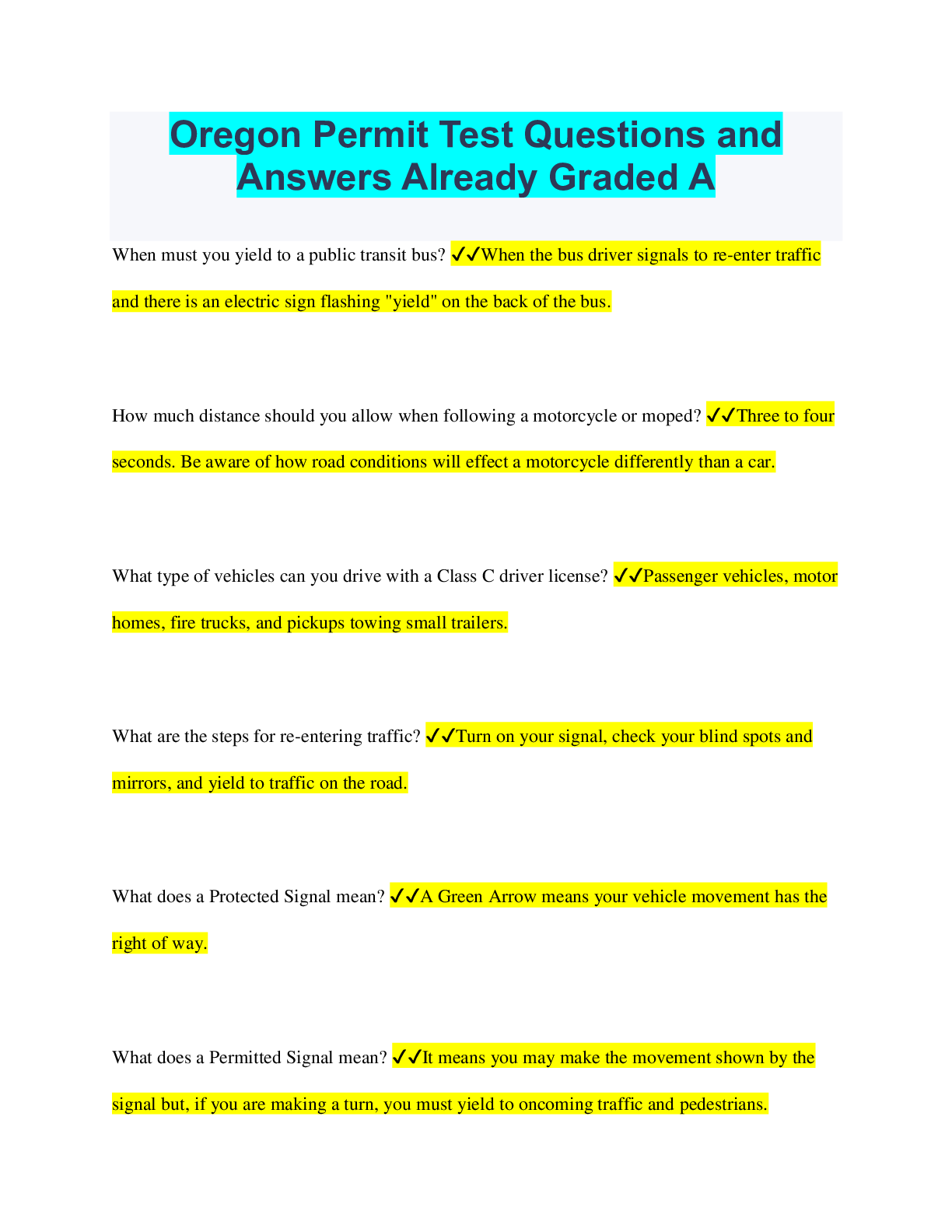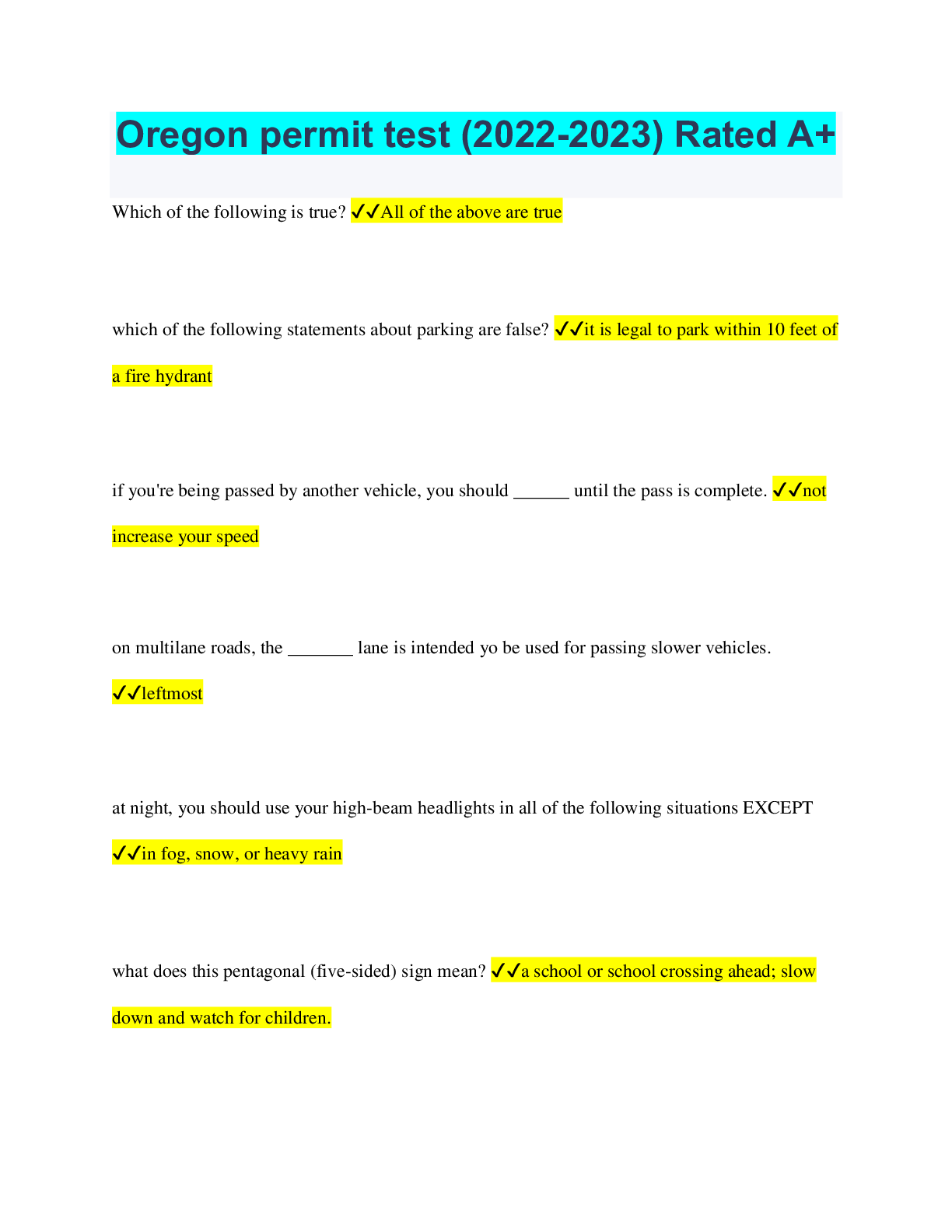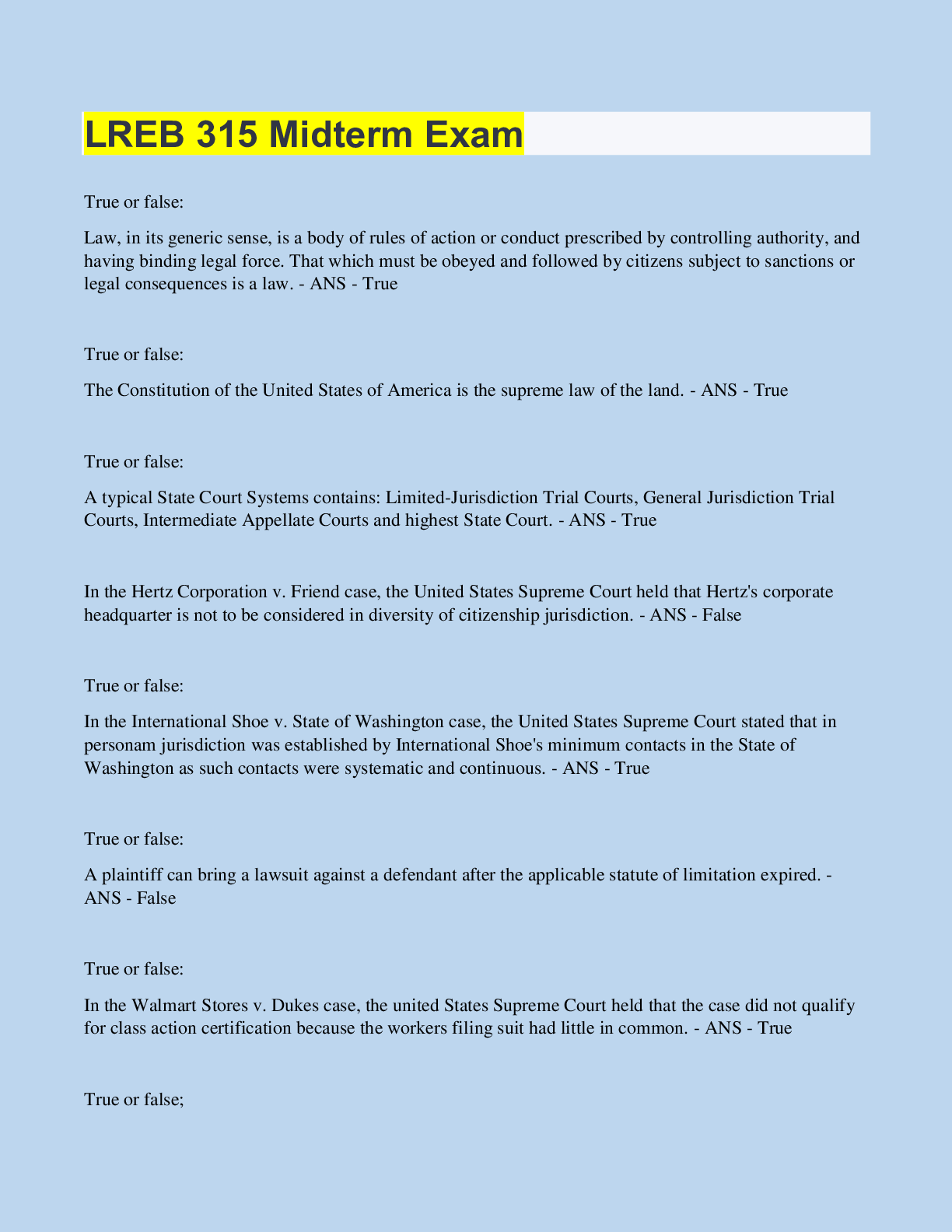*NURSING > QUESTIONS & ANSWERS > Medical-Surgical RN A Prophecy Relias Summer 2022 Exam Questions and answers Already Passed (All)
Medical-Surgical RN A Prophecy Relias Summer 2022 Exam Questions and answers Already Passed
Document Content and Description Below
Medical-Surgical RN A Prophecy Relias. Summer 2022 Exam Questions and answers. Graded. 1.2 milligrams is equal to how many micrograms? - Ans-1200 mcg Your post-op patient has a Jackson-Pratt (JP) ... drain in place. How do you ensure effective drain function? - Ans-Compress the drain, then plug the bulb to establish suction Your male patient complains of discomfort while inflating the balloon during insertion of an indwelling urinary catheter. What would be the MOST appropriate action? - Ans-Deflate the balloon, advance the catheter further, then reinflate the balloon Your patient has symptomatic anemia but is refusing a blood transfusion for religious reason. What is an appropriate response? - Ans-Respect his wishes and notify the provider Your patient is admitted with diverticulitis. What type of diet do you expect to be ordered for the patient? - Ans-broth, jello, soft fruit no skin, You were hired to work the medical unit and when you arrive at work the charge nurse has assigned you to the post-surgical unit since they are understaffed. Which is the MOST appropriate action? - AnsReport to the post-surgical unit. What is a proton pump inhibitor, such as pantoprazole (Protonix) used for? - Ans-Acid Reduction Which adaptive equipment would be MOST appropriate to use for a severely contracted patient who is unable to bear weight when transferring from the bed to the chair? - Ans-Patient lift (e.g., Hoyer) Which tool should you use to assess pain in you 80-year-old patient with severe dementia? - AnsPAINAD scale Your patient is admitted from the ED with failure to thrive and advanced dementia. You note he is extremely underweight, appears unbathed for some time, and has a stage 4 pressure injury to his coccyx. You were told in report that he lives at home with family members. What should you do? - AnsNotify the charge nurse and social worker of your concerns. Your 85-year-old patient with atrial fibrillation fell at home 3 days ago. You notice she has been having several episodes of acute confusion since being admitted to your unit. What is the MOST important order you should anticipate from the provider? - Ans-Stat CT of head Your patient has a temp of 102.3 F, HR 122, and has had 15 mL of urine from the indwelling urinary catheter in the last 2 hours. What is your patient MOST likely experiencing. - Ans-Sepsis What type of personal protective equipment (PPE) is applied prior to entering a room for a patient with C. diff? - Ans-Gown and gloves Your patient continues to pull at their IV site located in their left forearm despite verbal reminders and increased observation. The nursing assistant recommends using soft mitt restraints on the patient. What is your recommendation? - Ans-Request an order for soft mitts as they are the least restrictive Your patient was admitted for a hypertensive crisis and has a history of HTN, Parkinson's disease, depression, and alcohol use. On his second hospitalized day, you notice he is more anxious and restless than his baseline. What would be your FIRST nursing intervention? - Ans-Ask the patient when his last drink of alcohol was. What is the BEST indication of an acute neurological problem? - Ans-Change in level of consciousness While in a supine position your patient states, "I'm tired and cannot catch my breath." Physical assessment reveals jugular vein distention and a third heart sound (S3). These symptoms are indicative of what condition? - Ans-Heart failure Your new admission presents with a cough, unintentional weight loss, frequent night sweats, and bloody sputum. What type of isolation precautions should you initiate, if any? - Ans-Airborne precautions Patients with diabetes are at high risk for complications from damage to what body areas? - Ans-Nerve and kidney damage If your patient with a known history of diabetes is displaying symptoms of diaphoresis, cool skin, lethargy, and shakiness. What is your first action? - Ans-Check the patient's blood glucose level. Your patient tells you, "I hope I don't die, but if I do I don't want to be brought back.? You notice on her chart and wrist band that she is a full code. What would be the MOST appropriate action? - Ans-Discuss code status with the patient and follow up with provider to ensure the medical record reflects her wishes. Your coworker posted photos on social media from a birthday party they had for her in the unit breakroom. What should be your NEXT course of action? - Ans-No action is necessary because no PHI was displayed. Your new patient understands very limited English. How should you communicate with them when completing the admission assessment? - Ans-Use the organization's interpreter services. You are caring for a patient with a history of diabetes mellitus. You walk into the room and find the patient lethargic and diaphoretic. What is your first action? - Ans-Obtain capillary blood glucose level. Your patient is 4 hours post open appendectomy and has not voided yet. You note his lower abdomen is distended. What should you do NEXT? - Ans-Perform a bladder scan A patient with peritonitis presents with tachycardia, hypotension, and dehydration. What other assessment finding would you anticipate as part of your physical assessment? - Ans-Severe abdominal pain or rebound tenderness What is the EARLIEST sign indicating increased intracranial pressure (ICP)? - Ans-Level of consciousness In addition to pain, pallor, and pulselessness, a neurovascular assessment also includes checking for: - Ans-Paresthesia and paralysis You received a report on a patient that sustained a right hemisphere CVA 48 hours ago. What do you expect the patient to exhibit? - Ans-Left sided weakness of the leg, arm, and face. You are ordered to give digoxin (Lanoxin). Your patients vital signs are: BP 130/70, Temp 97.9F, HR 52, RR 16, O2 Sat 100% on room air. What should you do NEXT? - Ans-Hold digoxin (Lanoxin) and call the provider Upon entry to your patient's room, you find her sitting in High Fowler's position and complaining of shortness of breath. Her respiratory rate is 34 breaths/min and O2 sat is 84%. Which mode of oxygen delivery would MOST likely reverse these symptoms? - Ans-Non-rebreather mask Your patient is on contact precautions for active MRSA. What proper PPE should you use before entering the room? - Ans-Gown and gloves Your patient recently had a G-tube placed and intermittent enteral feedings have been initiated. What symptoms may indicate intolerance to the feedings? - Ans-Vomiting and diarrhea Upon entering your patient's room, you note that they are having a seizure. What is your FIRST action? - Ans-Position the patient on their side to maintain the airway. Your 18-year-old female patient was admitted with dehydration secondary to anorexia nervosa. During your assessment you note she has a flat affect and says, "I just want to die. I'm tired of my life." What should be your FIRST intervention? - Ans-Stay with the patient and ask fi she has a plan to carry out this wish. Your patient has a non-productive cough and presence of secretions in his tracheostomy. Prior to suctioning the patient, what should you do FIRST? - Ans-Hyperoxygenate patient. Your patient takes 5 mg of warfarn (Coumadin/Jantoven) daily and reports having black colored stool today. What do you most likely suspect? - Ans-Gastrointestinal bleeding Your new patient was admitted with blunt force trauma to the abdomen following a motor vehicle accident (MVA). A NG tube is in place for decompression; however, you note during the assessment that the stomach is rigid and hard during palpation. What condition do you suspect? - Ans-Hemorrhage Which of the following nursing diagnoses is MOST important for a patient with chronic obstructive pulmonary disease (COPD)? - Ans-Impaired gas exchange You have a patient going for dialysis. Their medications include lisinopril (Prinivil), ondansetron (Zofran), famotidine (Pepcid), and atorvastatin (Lipitor). Which medication would you possibly hold and seek clarification? - Ans-famotidine (Pepcid) What is an early symptom that the patient is developing a complication of heart failure? - Ans-Edema in the legs and feet Black and tarry colored stools are CLASSIC symptoms of what condition? - Ans-Bleeding gastric ulcer You have 4 patients who have high priority needs. One needs to go to surgery, one needs STAT lab draws from a PICC line, another has chest pain rated 8/10, and another needs toileting. Which patient should you tend to FIRST? - Ans-The patient with chest pain Your patient with Hepatitis C exhibits signs of [Show More]
Last updated: 2 years ago
Preview 1 out of 11 pages
.png)
Buy this document to get the full access instantly
Instant Download Access after purchase
Buy NowInstant download
We Accept:

Reviews( 0 )
$10.00
Can't find what you want? Try our AI powered Search
Document information
Connected school, study & course
About the document
Uploaded On
Jun 18, 2022
Number of pages
11
Written in
Additional information
This document has been written for:
Uploaded
Jun 18, 2022
Downloads
0
Views
170

.png)


